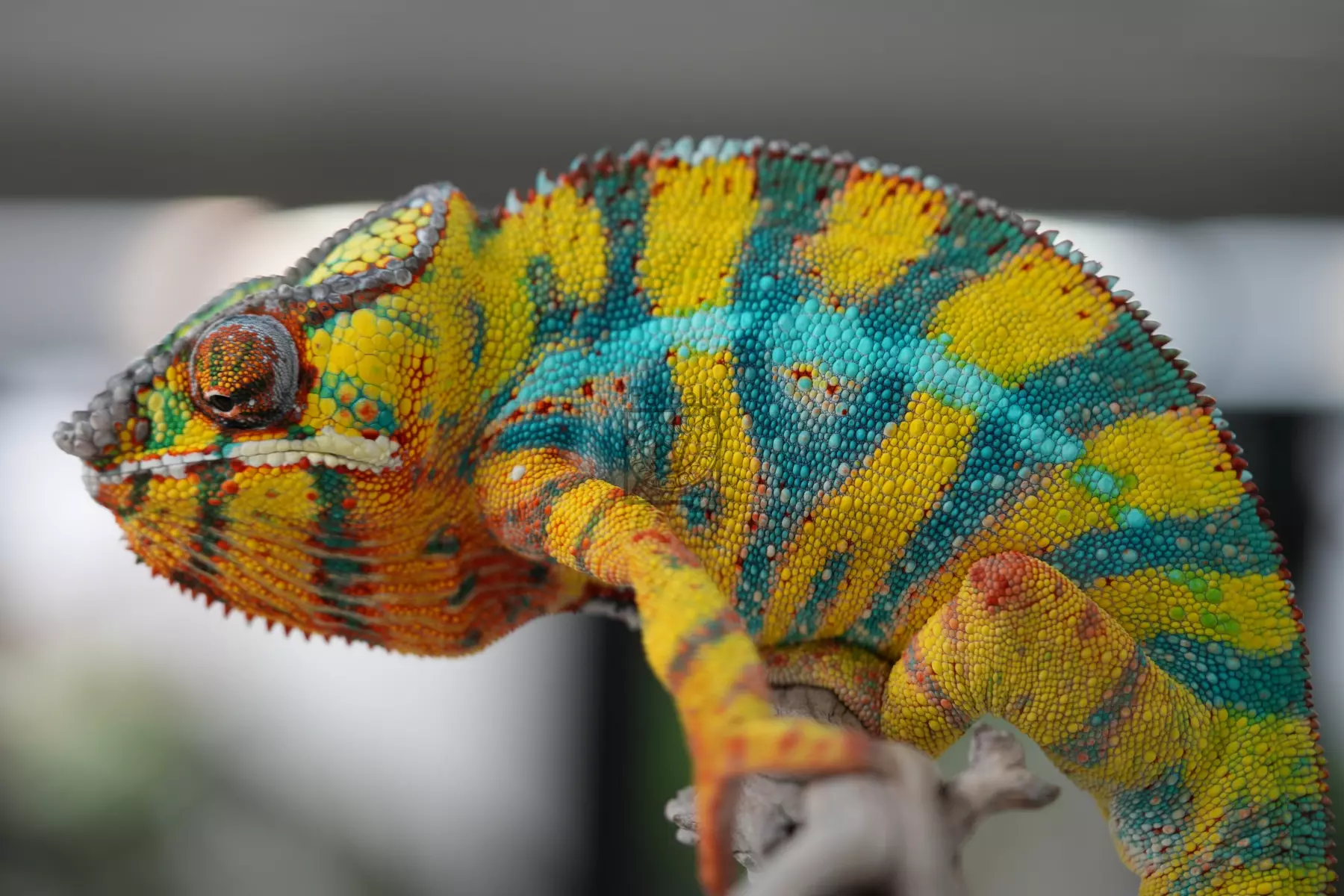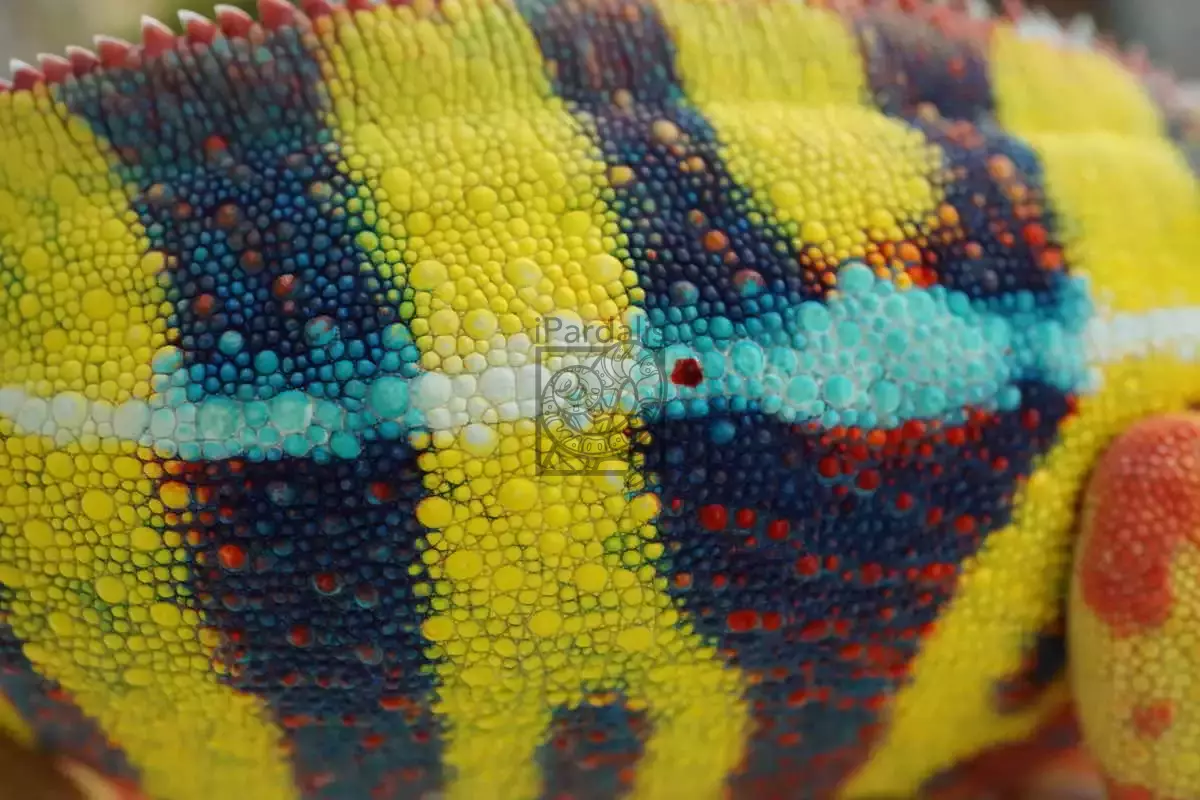Go Back
This is where we sell our Panther Chameleon females. Our female Panther Chameleons are exceptional pets due to their docile and calm nature. Unlike other chameleons, females rarely exhibit territorial or defensive behaviors, making them easier to handle and ideal for those seeking a more interactive pet (though chameleons are not highly interactive). Additionally, female chameleons display vibrant colors when receptive, with hues evolving through life stages. Their adaptable and social nature makes them well-suited for captivity, allowing enthusiasts to buy a pet without territorial issues. Many customers buy female panther chameleons because they want to see the full spectrum of color and behavior from their Panther Chameleons, and they won't experience that joy without the presence of a female chameleon.
Olimpia Martinotti wrote a great guide On the Specific Care of Females and we wrote our answers to Frequently asked Questions about Female Panther Chameleons below each of the exact female chameleons for sale here. We highly recommend reading both of those before buying a female panther chameleon from us. Feel to reach out with any questions we don't address on this page or the resources we provided here. We hope your buying experience is enjoyable and educational!
Females
Automatic volume discounts on 2+ animals
Frequently Asked Questions about our Female Panther Chameleons for sale

How can you tell if a Panther Chameleon is a female?
Female Panther Chameleons have a flat tail base immediately following their cloacal opening. Their rostral appendage is not as developed as a males’. Females tend to be about half the size of a male as adults, and their coloring is drastically different (see next question).
How Long do Panther Chameleons live?
- Male Panther Chameleon Life Expectancy: 5 - 12 years
- Female Panther Chameleon Life Expectancy: 4 - 7 years
In captivity, female Panther Chameleons live between three and six years. In the wild, it is rare for individuals to live longer than two or three years due to predation, extreme weather events, and harsh conditions. Advances in husbandry are extending their lifespans compared to five years ago.
What factors influence a Panther Chameleon’s lifespan?
Several factors influence the lifespan of a Panther Chameleon. Diet plays a pivotal role; a well-balanced nutrition plan, including a good gut loading strategy, with appropriate supplementation contributes to overall health. The quality of the habitat is crucial—maintaining optimal conditions, including temperature, humidity, and UVB lighting, directly impacts their well-being. Stress is a significant factor; minimizing disturbances and providing proper handling positively influences lifespan. Regular veterinary check-ups help detect and address potential health issues early on. In captivity, these considerations collectively contribute to extending the lifespan of a Panther Chameleon beyond what is typically observed in the wild.
Why do male and female Panther Chameleon have a different lifespan?
Male and female Panther Chameleons have slightly different lifespans mainly due to the impact of reproductive processes. Females often experience shorter lives, influenced by the energy-intensive activities of breeding and egg-laying. They are also very eager eaters and prone to obesity in captivity.
What are the signs of aging in Panther Chameleons?
Signs of aging in Panther Chameleons include changes in appetite, decreased activity levels, and alterations in coloration. As they age, some chameleons may exhibit reduced vibrancy in their markings. Regular veterinary check-ups become crucial to monitor and address age-related health issues. You may need to accommodate the evolving needs of your aging Panther Chameleons and ensure their well-being with more branches or frequent misting sessions. Jude needs the water to come to him a bit more than he did when he was younger.
How do I ensure my Panther Chameleon reaches maximum life expectancy?
Check out The Chameleon Academy and learn about the latest husbandry techniques if you want to join us and shoot for that upper limit! We have not had enough chameleons living under controlled conditions with natural sources of hydration long enough to know what that top limit actually is.
Female Panther Chameleons as Pets
What color are female Panther Chameleons?
Female Panther Chameleons are typically pastel orange, peach, purple, and pink with a tan to brown base and some banding along their bodies. They often have small splashes of color on their cheeks and body. When receptive, they can exhibit a stunning array of colors, including yellow, blue, purple, pink, or orange. However, their hues tend to be more pastel compared to the solid shades seen in males.
Do Female Panther Chameleons change color?
Absolutely! Female Panther Chameleons change color for communication, similar to males. When receptive, they exhibit a stunning array of pastel colors. Another significant color change occurs when they are gravid (pregnant), with resting colors darkening, and they may turn pitch black and gape their mouths when encountering a male to signal pregnancy.
Are Female Panther Chameleons Friendly?
Female Panther Chameleons tend to be less territorial and more food-motivated, making it easier to establish a positive association with their food. While they do not need human interaction, they are generally more docile than males. However, defensive behavior can still occur.
Can Female Panther Chameleons Live Together?
No, all chameleons need their own living space. While females do not engage in combat like males, they establish a hierarchy. Most captive environments lack sufficient space for multiple females, leading to stress, illness, and complications during egg-laying. Even dominant females are negatively affected by the need to maintain their position.
How Big to Female Panther Chameleons Get?
Females typically weigh between 50 and 70 grams and measure 10"-12" from head to tail when fully grown, roughly half the size of adult males.
How do you house Female Panther Chameleons?
We prioritize creating a naturalistic setup for our female Panther Chameleons, allowing them to dig and lay their eggs in a substrate that closely mimics the forest floor. Typically, we achieve this using a fully planted, bioactive Large Reptibreeze enclosure. This approach has proven effective in reducing egg-laying complications, as the females often prefer to lay their eggs in the plant’s root ball. Additionally, they tend to dig shallow holes, finding security in the leaf litter provided.

Egg Laying Questions
Do Female Panther Chameleons Lay Infertile Eggs?
Yes, female Panther Chameleons lay infertile eggs, influenced by temperature and food. If not breeding, regulate her clutch size and frequency with lower temperatures and fewer food items to limit it to 20 eggs or fewer.
How Many Eggs Does Female Panther Chameleon Lay?
A female Panther Chameleon can lay between 10 and 50 eggs, with the average clutch size around 25 eggs. We aim for 20-25 eggs per clutch and reduce feedings and temperatures if a female lays more than that to avoid large clutches, which can shorten her lifespan.
Why Do Many Female Chameleons Die After Laying Eggs?
Usually, fatal complications from egg laying are caused by husbandry mistakes such as over feeding, dehydration or lack of proper nutrition. If the laying site is inadequate, some female chameleons will die of exhaustion looking for a proper place to dig and lay her eggs. A healthy female chameleon should be able to lay her eggs without complications in a suitable location.
How to Tell if Your Female Panther Chameleon is Gravid (Pregnant)?
A gravid female will refuse a male by gaping her mouth and turning pitch black. At rest, she will often display darker hues of purple and more pronounced barring. As she progresses, egg outlines may become visible on her sides.
How Often do Female Panther Chameleons Lay Eggs?
A receptive female panther chameleon will lay her eggs within 30-45 days of mating, and then lay again within 60 days of that first clutch. We call that her retained clutch. She may lay a second or third retained clutch on a similar cadence if she is healthy. When she is done with her retained clutches, she will enter another receptive cycle. Egg sellers will probably just breed her again without letting her rest adequately.
iPardalis listings are exclusively juveniles or older - no hatchlings or eggs - we do not sell juveniles under 12 grams of weight regardless of their age. Every iPardalis Panther Chameleon has a life-long guarantee. Whatever issue you encounter, even years later, we want to be part of the solution. Keep in touch, and we will ensure that you have a positive experience.
Visit our Facebook or Instagram for regular updates on our project. Our blog covers Panther Chameleon genetics, ethics, photography, podcasts, husbandry and more.
Please let us know if you have any questions about our Female Panther Chameleons for sale.



